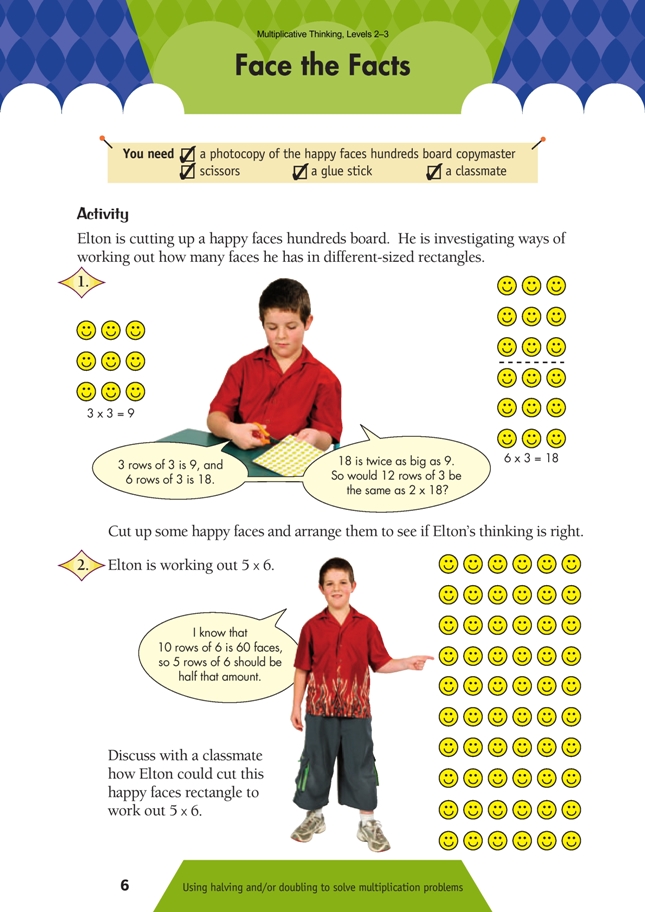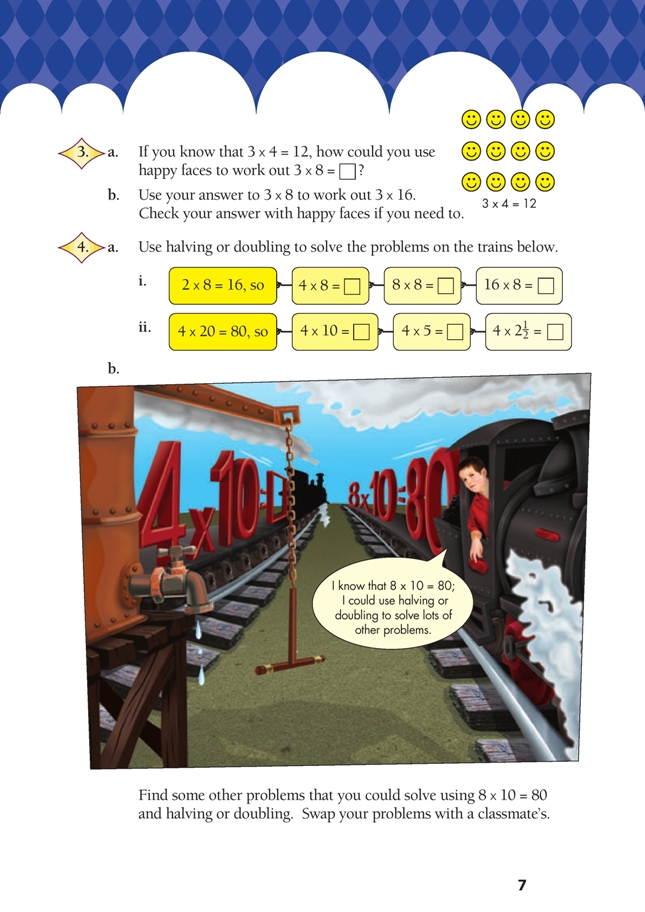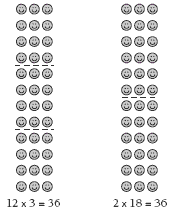This is a level 3 number activity from the Figure It Out series. It relates to Stage 6 of the Number Framework.
A PDF of the student activity is included.
Click on the image to enlarge it. Click again to close. Download PDF (639 KB)
use arrays to solve multiplication problems using doubling and halving strategies
Number Framework Links
This activity would be suitable for guided instruction with students at stages 5 or 6. Students at stage 7 may be able to do this independently.
Copymaster of Happy Faces Hundreds board
FIO, Levels 2-3, Multiplicative Thinking, Face the Facts, pages 6-7
Scissors, Glue stick
A classmate
These pages use a powerful model of multiplication, the array, to help students develop multiplicative rather than additive strategies. The array embodies the structure of multiplication, with one factor represented by the length and the other by the width. The structure may seem obvious to us, but research suggests that students do not automatically recognise the pattern of rows and columns. It is important to bear this in mind as you watch your students work with the happy faces (see also Material Master 6-5). Get them to talk about what they can see in the pattern to determine if the mathematics of these activities makes sense to them. There is a lot of mathematics embedded in these activities; this page could form the basis of rich work for a week with a group at stages 5 or 6.
You could introduce this activity with some everyday objects that have an array structure, such as egg trays/cartons, muffin pans, or inside trays from boxes of chocolates. Ice cube trays and boxes of apples are used on page 9 of Basic Facts, Figure It Out, levels 2–3. This could be used to support students who are having difficulty with the larger collections on these pages.
For question 1, it’s important that students are able to manipulate the faces to see the new arrangement of rows and columns. This will encourage multiplicative thinking. The reasoning that Elton is describing requires thinking about the factors and the product in relation to each other and predicting what will happen if the amounts change. To extend this activity, ask the students to make predictions like Elton’s, based on what they have observed: “I know … so would …?” Use the faces to explore these predictions.
Question 2 again confronts students with multiplicative reasoning. Encourage lots of discussion to see if the students can follow what Elton is doing and provide additional examples such as 10 rows of 4 or 10 rows of 8 if further reinforcement is needed.
To solve question 3, students are asked to employ the reasoning from the earlier questions. Listening to your students’ answers and observing who can solve this without the faces or who is using additive methods will give you useful assessment information.
Question 4 further extends the use of halving and doubling because it moves away from the faces model to working with just the numbers. This reflects the Numeracy Development Project teaching model and seeks to get students working with number properties. As above, it will provide a useful checkpoint for your students’ thinking. Extend this by setting up some trains of your own in which halving and doubling would be a useful strategy and then challenge the students to think of some
other examples. Part b is an open-ended opportunity for students to apply this strategy. Students who use fractions, as in part a ii, are showing effective multiplicative thinking.
Consider finishing this work with a discussion of when halving and doubling might be “the best” strategy to use. Ask:
• Does halving and doubling work with any multiplication?
• Why is halving and doubling more appropriate in some situations than in others?
• What sorts of numbers does halving and doubling work well with?
Students need to learn when to apply particular strategies as well as knowing how they work.
Answers to Activities
1. Yes, Elton’s thinking is right. 6 x 3 = 18, 12 x 3 = 36, and 2 x 18 = 36.
2. He could make a cut after 5 rows because there are 6 faces in each row.
10 x 6 = 60
5 x 6 = 30 or half of 60 is 30.
3. a. You could double each row of 4 to make 8.
3 x 8 = 24.
3 x 8 = 24
b. 3 x 8 = 24, so 3 x 16 = 48 because 16 is double 8 and so the answer is double 24.
2 x 24 = 48.
4. a. i. Doubling: 2 x 8 = 16, so 4 x 8 = 32, 8 x 8 = 64, 16 x 8 = 128. (Another
doubling sequence, using only the first part of the train, would be: 2 x 8 = 16,
2 x 16 = 32, 2 x 32 = 64, 2 x 64 = 128.)
ii. Halving: 4 x 20 = 80, so 4 x 10 = 40 (10 is half of 20, and 40 is half of 80),
4 x 5 = 20 (5 is half of 10, and half of 40 is 20), 4 x 2 = 10 (2 is half of 5,
and half of 20 is 10).
b. Some problems that could be solved are:






